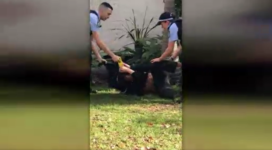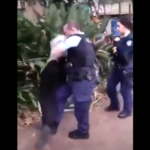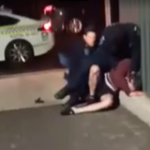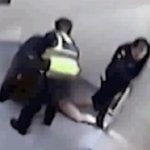Sydney Man Tasered in Face, as Australian Police Continue Assault on First Nations

Despite ongoing mass demonstrations calling for an end to police brutality towards First Nations people sweeping the country, state police officers are continuing to be caught on video perpetrating acts of extreme violence against Aboriginal civilians.
Indeed, with the onset of modern technologies – such as camera phones and social media platforms – it seems gone are the days of keeping these episodes hush-hush.
The most recent incident occurred on Monday, as NSW police were conducting “proactive patrols” in inner city Darlinghurst, and a pair officers spotted a man and a woman walking down Oxford Street.
“As officers approached,” a police statement said, “the pair split up and the 32-year-old man – who was carrying a bag – fled on foot.”
Phone camera footage clearly displays the officers standing in front of Aboriginal man Kris Lovelock, calling on him to get down, while he is kneeling with his arms stretched out in front of him and his hands touching the ground. Then a male officer goes awol with his taser.
The officer literally pulls Lovelock back up onto his feet, while tasering him at close range in the face. Lovelock cries out in pain, as the officer then tasers him in the lower back, again in the face, and then, as he cowers on the ground, he’s repeatedly tasered in the torso and face.
“I’m not even fighting you,” Lovelock cries out to the taser-happy officer. “Are you kidding me?”
Riding without a helmet
The face tasering is only the latest footage that’s appeared on social media recently, revealing the excessive force that police officers seem to be exerting towards First Nations people across the country.
South Australian police officers who were attending a 15 June call out to an Adelaide home were captured on multiple phone cameras holding Aboriginal man Noel Henry down on the ground against a fence, with his head pressed into the raised concrete fence foundation.
The 28-year-old was in the vicinity of the house officers were there to attend. He was on a bike without a helmet. On approach, the officers didn’t say they were concerned about him being involved in the matter they’d been called to, but rather cited illicit drugs as the reason to stop him.
Multiple witnesses call on the officers to let the man up as the footage continues, then one of the officers on top of him commences striking Henry repeatedly. This happens while the three of them clearly have him restrained with his legs on the ground and his head on the block.
After being taken to the local police station, Henry was charged with resisting police, as well as property damage. He was then released without further investigation, with no charges pending, meaning the officers who said they suspected him of drug possession were wrong.
Just having “a bad day”
Then there was the 1 June incident in a park in Sydney’s Surry Hills. It was the day before the first Black Lives Matter protest was to take place in the city. And obviously, the officer wasn’t aware of the global outcry over police brutality towards people of colour that was all over the news.
The episode in the park was again captured on a camera phone. The NSW police constable involved is shown to grab a 16-year-old Aboriginal boy, pin his arms behind his back, kick his legs out from under him and throw him face first onto the ground.
The officer did this over a rather unthreatening threat the teenager made, as part of a verbal to and fro the officer was clearly engaged in prior to the assault. And there was no indication the youth standing metres away from him posed any threat to the officer whatsoever.
NSW police commissioner Mick Fuller put the incident down to one of his officers having “a bad day”, while the boy’s mother told a press conference that her family is quite used to being hounded on the street for being Aboriginal.
NSW Greens MLC David Shoebridge subsequently told NSW state parliament that this case of “racist policing” on the part of the constable was related to the youth “being black in a public place”, which he asserts is “still a crime in this state”.
Police investigating police
Justice advocates have raised the issue that for all three of these events, the state police forces that produced the officers that are conducting themselves in this manner on the street are the same institutions that will be investigating the matters.
And the reason why this isn’t an adequate set of circumstances has been put on display again this week, as a WA police probe into the force used during an arrest, where a local police officer caused an Aboriginal teenager’s head to slam onto a footpath, was deemed “necessary and not excessive”.
This time the incident was captured on CCTV footage. It shows five WA police officers surrounding a First Nations youth outside Perth train station on 7 July 2018. Apprehended, the handcuffed teen is dragged over to a concrete block and made to sit on it.
Moments later, the youth appears to say something, and then one of the officers drags him off the block causing him to fall and smash his head on the ground. The officer in question then presses down on the teen’s back, while the others look on, before casually walking away.
On hearing the victim cry out, an eyewitness, who appears to be a young woman, is seen to question the officers about their actions. She’s then promptly led over to a fence and arrested for obstructing police, although the charge was later dropped, as the police statements didn’t match the footage.
The internal police investigation found “the level of force the police officers used” was “necessary”. And the officer who dragged the teenager face first onto the ground had claimed he’d done so as he thought the detainee had spat at officers or that he was about to spit at them.
The 226th recommendation of the Royal Commission into Aboriginal Deaths in Custody states that a “totally independent” body should investigate police incidents.
However, most of the Royal Commission’s 339 recommendations have never been acted upon.







